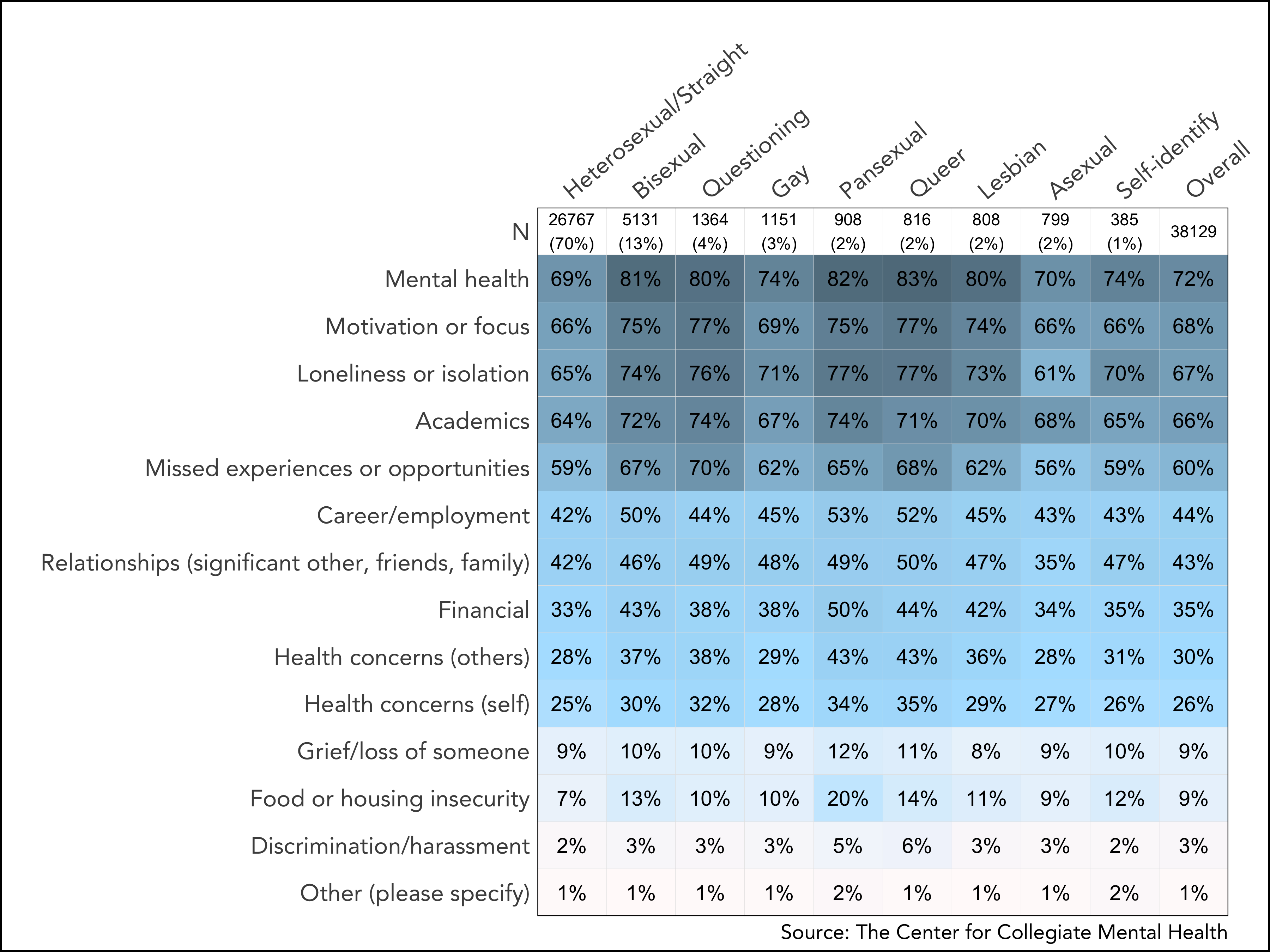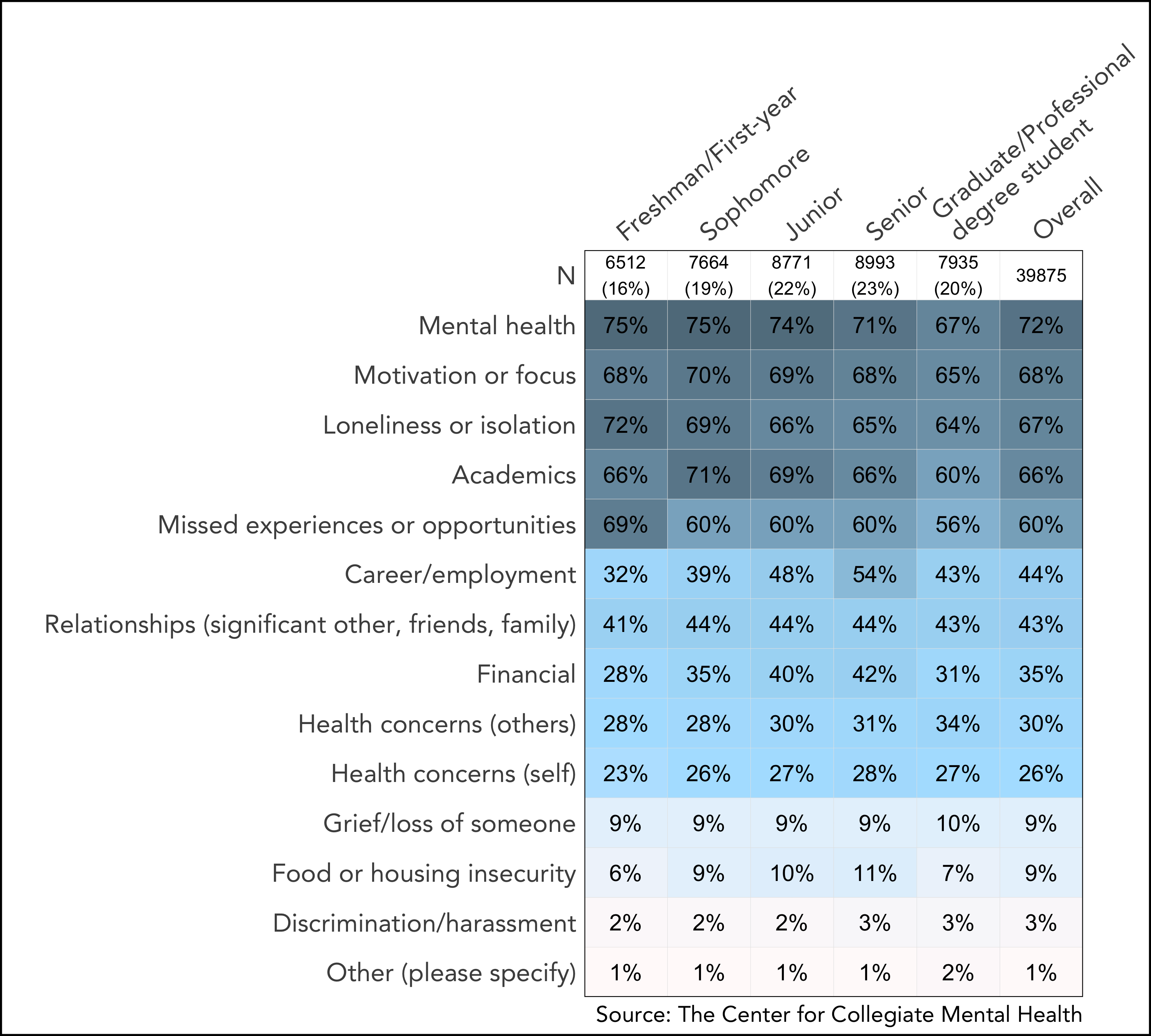Part 3 of 5: Mental Health Impact of COVID-19 on Various Demographic Groups
The impact of COVID-19 has led to widespread concerns about its unique effects on college students’ mental health. To examine this topic more broadly, CCMH is completing a five-part blog series using a wide range of longitudinal clinical data from students seeking mental health services at college counseling centers nationally.
Update: Numbers in this blog were corrected on October 4, 2021 to exclude clients who did not complete the COVID impact form, which increased rate of endorsement for each COVID impact area by <10%.
In Part 1, CCMH explored the role of COVID-19 in mental-health help-seeking and the rates at which students reported negative impacts from COVID-19 across various aspects of their life. In Part 2, we explored how student distress and clinician-identified problems changed nationally before and after the onset of COVID-19. In this blog, Part 3 of 5, CCMH will explore how 12 negative impacts of COVID-19, as reported by students seeking mental health treatment, varied according to 9 different demographic characteristics. Specifically, this blog will look at the interactions between the variables in the table below.
|
Which area(s) of your life have been negatively
impacted by COVID-19? (check all that apply)
|
Demographic Characteristics |
| 1. Academics | 1. Academic standing |
| 2. Career/employment | 2. Race/ethnicity |
| 3. Discrimination/harassment | 3. Gender identity |
| 4. Financial, food, or housing insecurity | 4. Sexual orientation |
| 5. Grief/loss of someone | 5. International student status |
| 6. Health concerns (others) | 6. First generation |
| 7. Health concerns (self) | 7. Varsity athletics |
| 8. Loneliness or isolation | 8. Disability status |
| 9. Mental health | 9. Military service history |
| 10. Missed experiences or opportunities | |
| 11. Motivation or focus | |
| 12. Relationships (significant other, friends, family) | |
| 13. Other (please specify) |
To explore these relationships, CCMH reviewed data from 43,098 college students seeking treatment at 137 counseling centers during the Fall 2020 (7/1/2020 to 11/30/2020). This data is gathered from students at the beginning of counseling center treatment via the Standardized Data Set (SDS). To explore how the impacts of COVID-19 varied across demographic groups, the rates of each of the 12 negative impacts will be reviewed across 9 demographic variables. Please note:
- Tables are sorted in descending order by the “Overall” frequency rate.
- Color coding (dark blue to light gray) helps to visualize differences within each set of identities.
- Many variables provide for a free-response/write-in option, which is labeled as “Self-Identify”.
Academic Class Status
Students are asked to indicate their “Current academic status” by selecting one of the options listed below. Results indicate that “Freshman/First-year” students reported the highest rates of COVID-19 negative impact on mental health, loneliness or isolation, and missed experiences or opportunities. Seniors indicated the greatest rate of negative impact in the areas of career and finances. Compared to both the overall student group and sub-groups, graduate students generally endorsed lower rates of negative impacts in most areas with the exceptions of health concerns, grief/loss, and discrimination/harassment.
Race/Ethnicity
Students are asked “What is your race/ethnicity?” with the response options listed below. Results indicate that students who identified as American Indian or Alaskan Native reported the highest rates of negative impact in the areas of financial, personal health concerns, grief/loss, and food/housing insecurity. Compared to all other race/ethnic identities, students who identified as African American/Black reported lower rates of negative impact in areas including mental health, motivation, loneliness, and academics. Students identifying as African American/Black, American Indian or Alaskan Native and Native Hawaiian or Pacific Islander reported the highest rates of grief/loss. The highest levels of discrimination/harassment were reported by students identifying as Asian American, African American/Black, and Native Hawaiian or Pacific Islander, while students identifying as Native Hawaiian or Pacific Islander indicated the greatest rate of negative impact on relationships (significant other, friends, family).
Gender Identity
Students are asked “Which of the following best describes your gender identity?” with the response options listed below. Results indicate that students who identify as Transgender man and Non-binary reported higher rates of negative impacts from COVID-19 in almost every domain when compared to both the overall group and all other groups. Students identifying as Transgender woman reporting significantly lower rates of negative impact in many areas compared to the overall and other minority identity groups.

Sexual Orientation
Students are asked “Which of the following best describes your sexual orientation?” with the response options listed below. Results demonstrate that students who identify as Bisexual, Questioning, Pansexual, Lesbian, and Queer reported higher rates of negative impacts from COVID-19 in areas including mental health, motivation or focus, loneliness and isolation, academics, and missed experiences or opportunities. Additionally, students identifying as Pansexual or Queer demonstrated the highest rates of impact in almost all areas.

International Student Status
Students are asked “Are you an international student?” with response options Yes or No. Results show that students who identify as international reported lower rates of negative COVID-19 impacts in almost all domains compared to domestic students. However, international students reported three times the rate of Discrimination/Harassment compared to domestic students.

First Generation Student Status
Students are asked “Are you the first generation in your family to attend college?” with response options Yes or No. Results demonstrate that both groups reported broadly similar rates of negative impact from COVID-19. However, First Generation college students reported slightly higher rates of negative impact in the areas of career/employment, financial, and food or housing insecurity.

Varsity Athletic Status
Students are asked “Do you currently participate in any of the following organized college athletics? (Intramurals, Club, Varsity),” and then answer Yes or No to each form of participation. For this blog, we compared non-athletes to students who reported varsity-athletics participation. Results indicate that students who identify as varsity athletes reported lower rates of COVID-19 impacts in almost every domain.
Disability Status
Students are asked “Are you registered, with the office for disability services on this campus, as having a documented and diagnosed disability?” with response options Yes or No. Results show that students who indicate having a registered disability reported broadly similar rates of negative impact to those who did not report a disability. However, students reporting a disability endorsed slightly higher rates of impact on mental health, academics, and health concerns (self and others).
Military Service History
Students are asked “Have you ever served in any branch of the US military (active duty, veteran, National Guard or reserves)?” and then indicate Yes (Military Service) or No (No Military Service). Students who reported military service reported higher rates of negative COVID-19 impact in areas of grief/loss and food or housing insecurity. In all other areas, students reporting military service endorsed lower or similar rates of negative COVID-19 impacts.
Summary and Suggestions
In this blog, Part 3 of 5, CCMH explored how 12 different negative impacts of COVID-19 differentially affect students seeking mental health services across 9 different demographic variables. This review included 43,098 students from Fall 2020 who sought mental health treatment at 137 college and university counseling centers. Results are too detailed and numerous to review individually but collectively they highlight the complexity with which COVID-19 is impacting college students. Readers are encouraged to closely examine the analysis that will inform your unique work with students.
If there is one stand-out result across all analyses, it is that mental health was consistently the most reported negative impact of COVID-19 across 36 of 38 demographic identities even though only 1/3 of students in this sample sought mental health services because of COVID-19. The only exceptions to this trend were among African American students and students who self-identified their race/ethnicity. These groups identified “motivation or focus” as the most common concern, followed by mental health. While the general mental health impact of COVID-19 was made clear in Blogs 1 and 2, this consistent result across demographic groups suggests that colleges and universities should be actively preparing to support student mental health needs in the coming year. The demand for mental health services increased annually pre-COVID; these results suggest that next year’s increase could be larger than usual.
In addition, the Academic Status variable suggests that colleges and universities should be attending to the needs of students in a developmentally differentiated manner during the transition into the 2021-2022 academic year. Specifically, first-year students appear to be coping with more significant impacts of missed experiences than their peers, and this could have institutional consequences for years to come. Conversely, seniors report being most impacted in career/employment and will benefit from focused support during the approaching end of their academic career. It is also worth noting that senior students reported elevated impacts in the areas of finances and food/housing, which could be an important focus this spring. These trends suggest that colleges and universities would be wise to explore interventions that specifically attend to student-needs based on their developmental levels. For example, assuming a return to campuses in Fall 2021, programming could emphasize providing sophomores with some of the experiences missed in Fall 2020 (that help to anchor them to the institution) and seniors with programming to support their career and financial needs.
Across the other variables examined, it is important to note that both large and small differences were discovered between the various identity groups, but the lowest rates of negative impact were often associated with majority identity statuses. There is no question that COVID-19 is profoundly impacting all students. With that being said, the data reviewed here highlight that the negative impacts of COVID-19 are often reported disproportionally by students with minority identities, which is likely to be heightened for students with multiple intersecting minority identities. For example, 61% of students who identified as African American/Black reported that their mental health was negatively impacted due to COVID-19, but this rate significantly increased to 72% if those students also identified as Bisexual.
On the other hand, some identity groups did not demonstrate large differences that might have been predicted (e.g., race/ethnicity, first-gen, military experience, international, etc.). While further research will be needed to fully unpack the nuanced relationship between COVID-19 and each of these identity groups, colleges and universities are encouraged to consider how these results can be used to inform programming and support services at their campus.
Please stay tuned for Part 4 of the CCMH COVID-19 Blog series where we will explore utilization trends.






